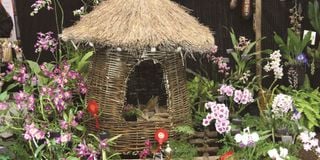Premium
A visit to the Orchid Manyatta

One of the Orchid Manyatta displays.
We have three orchid plants in our garden. They are growing at just above eye-level on trees but, to be honest, I haven’t paid much attention to them.
The blooms are quite small — nothing like the big fleshy and exotic ones I used to buy for a girlfriend, if I really wanted to impress her.
No, my eyes swivel more eagerly for the garden birds — for the Augur Buzzard that has a chick in its nest high on a tree, for the Goshawk that occasionally swoops for the Bronze Mannikins pecking at grains on the terrace, or for the young and very nervous Hadada Ibis that is on a high branch and contemplating his first flight. But for the orchids, not really.
However, last Sunday I was persuaded to go to the annual show of the Kenya Orchid Society at the Sarit Expo Centre. In the morning, I did a little research. I found out that it is the oldest orchid society in Africa. It has about 150 members and, judging by the quality of the exhibition and the conversations I had there, they are meticulous but passionate about their orchids.
I was also surprised to learn that there are over 25,000 species of orchid growing across the world, but especially in the wet tropics. They make up one of the most diverse plant groups, in terms of colour, appearance and size.
A plant can last for 100 years. And I was amused to find out that the name orchid is derived from the Greek word for testicle. I haven’t yet worked out why, but I guess it has more to do with the root than with the flower.
Impressed
I wasn’t sure what to expect when my wife, Lut, and I went to the show. But when we got there we were certainly impressed. We also understood why it was called the Orchid Manyatta. All the main displays were arranged in a way that incorporated the Maasai and manyatta theme. It was all ingenious and very colourful.
The show also incorporated an exhibition of paintings on the orchid manyatta theme done by children from schools in and around Nairobi. That was very impressive, too. Many of the paintings were of high and imaginative quality. There was also a section with plants and plant pots for sale.
It seems that most of the exhibitors were women – mostly Asian women – who have found a very fascinating and absorbing hobby for themselves. And there was an evident sense of pride in the few we were able to talk with.
Among them was Salima Tejani, who has just been made an international judge of orchids. And there on display was a new hybrid that has been named after her.
At a more mundane level, we were able to find two examples of the three plants growing in our garden. So now we know their names: Rangaeris amaniensis and Brassidium Golden Gamine. Why is it that we feel we can’t fully appreciate something – an animal, a bird or a flower – until we know its name. But I will certainly appreciate all three of our own orchids – even the one without a name – now I have been to the Orchid Manyatta.
If this article has sparked your interest in the Kenya Orchid Society, then I suggest you Google it, and you will find a lot about it and even more about orchids.
I must also mention Big Bad Wolf Books. It says on its website that its mission is to cultivate reading habits and increase English literacy worldwide.
It was holding a huge book fair and sale in the neighbouring exhibition hall to the Orchid Manyatta. It is the first time I have seen people queuing at the checkouts with supermarket trolleys full of books.
John Fox is Chairman of iDC Email : [email protected]





